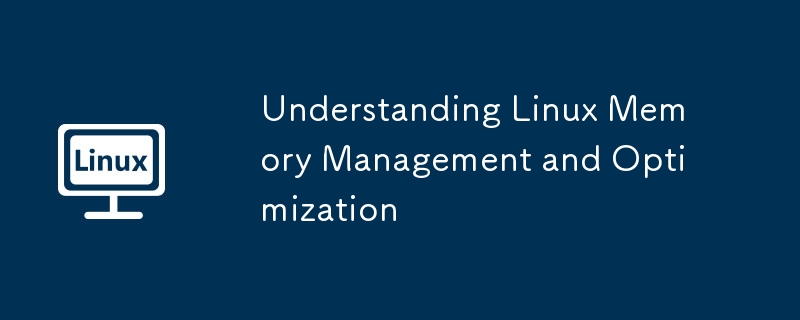Linux efficiently uses memory by caching files and buffers, so high "used" memory is normal if "available" memory is sufficient. 2. Swap helps prevent crashes on low-RAM systems or during spikes but should be limited on systems with ample RAM or SSDs to avoid performance degradation and wear. 3. Adjust swappiness (e.g., set to 10) to reduce swap usage and prioritize physical memory. 4. Manually clearing cache (via drop_caches) is rarely needed and can hurt performance temporarily. 5. Monitor memory with tools like htop, vmstat, and sar, and optimize by limiting runaway processes and tuning application memory use. 6. Focus on system responsiveness and available memory rather than used memory when deciding to optimize, as high usage with adequate available memory indicates efficient resource utilization, not a problem.

Linux memory management is often misunderstood, especially when interpreting tools like free, top, or htop. What looks like “l(fā)ow memory” on the surface might actually be a sign of efficient usage. Understanding how Linux manages memory—and how to optimize it—is key to maintaining system performance, especially on servers or resource-constrained environments.

How Linux Uses Memory Efficiently
Unlike some operating systems that leave RAM idle, Linux tries to use as much memory as possible to improve performance. This includes:
- Application memory (RSS): Memory actively used by running processes.
- Page cache: Frequently accessed files are cached in memory so that subsequent reads are faster.
- Buffers and shared memory: Temporary storage for disk I/O and inter-process communication.
When you run free -h, you might see something like this:

total used free shared buff/cache available Mem: 8.0G 6.5G 200M 400M 1.3G 1.1G
Beginners often panic at the high “used” value. But the real metric to watch is available, which accounts for memory that’s currently used for cache but can be freed instantly if an application needs it.
Key insight: High “used” memory with plenty of “available” is normal and desirable.
Swap: When and How It Helps
Swap space is disk storage used as an extension of RAM. While much slower than physical memory, it prevents the system from crashing when RAM is fully utilized.
When swap is useful:
- On systems with limited RAM.
- During memory spikes (e.g., large file processing).
- To allow hibernation (suspend-to-disk).
When to limit swap usage:
- On systems with ample RAM, aggressive swapping can hurt performance.
- SSDs wear out faster with heavy swap usage.
You can control how aggressively the kernel uses swap via the swappiness parameter:
cat /proc/sys/vm/swappiness # Default is usually 60
To reduce swapping (e.g., for a desktop or server with lots of RAM):
echo 'vm.swappiness=10' | sudo tee -a /etc/sysctl.conf sudo sysctl -p
A value of 10 tells the kernel to avoid swap unless absolutely necessary.
Clearing Cache (Only When Necessary)
Linux automatically manages cache, but in rare cases—like before running a memory-intensive benchmark—you might want to manually clear it:
# Clear page cache, dentries, and inodes echo 3 | sudo tee /proc/sys/vm/drop_caches
?? Warning: This is generally unnecessary and can temporarily degrade performance, as cached data must be reloaded from disk.
Monitoring and Optimization Tips
Use these tools and practices to keep memory usage in check:
htoporbtop: Visualize memory usage per process.vmstat 1: Monitor paging activity (watch for highsi/sovalues indicating heavy swap usage).sar -r(from sysstat): Historical memory usage analysis.- Limit runaway processes: Use
ulimitto cap memory per user or process. - Tune applications: Reduce memory footprint of services (e.g., JVM heap size, database buffers).
For example, if running a web server:
# Limit processes to 2GB of RAM ulimit -v 2097152
Conclusion
Linux memory management is designed to be efficient, not minimal. High memory usage isn’t a problem if the system remains responsive and applications have room to grow. The key is understanding the difference between used and available memory, tuning swap behavior, and monitoring real performance, not just numbers on a screen.
Basically: don’t optimize just because memory looks “full.” Optimize when performance suffers—and then, look at the right metrics.
The above is the detailed content of Understanding Linux Memory Management and Optimization. For more information, please follow other related articles on the PHP Chinese website!

Hot AI Tools

Undress AI Tool
Undress images for free

Undresser.AI Undress
AI-powered app for creating realistic nude photos

AI Clothes Remover
Online AI tool for removing clothes from photos.

Clothoff.io
AI clothes remover

Video Face Swap
Swap faces in any video effortlessly with our completely free AI face swap tool!

Hot Article

Hot Tools

Notepad++7.3.1
Easy-to-use and free code editor

SublimeText3 Chinese version
Chinese version, very easy to use

Zend Studio 13.0.1
Powerful PHP integrated development environment

Dreamweaver CS6
Visual web development tools

SublimeText3 Mac version
God-level code editing software (SublimeText3)

Hot Topics
 Install LXC (Linux Containers) in RHEL, Rocky & AlmaLinux
Jul 05, 2025 am 09:25 AM
Install LXC (Linux Containers) in RHEL, Rocky & AlmaLinux
Jul 05, 2025 am 09:25 AM
LXD is described as the next-generation container and virtual machine manager that offers an immersive for Linux systems running inside containers or as virtual machines. It provides images for an inordinate number of Linux distributions with support
 7 Ways to Speed Up Firefox Browser in Linux Desktop
Jul 04, 2025 am 09:18 AM
7 Ways to Speed Up Firefox Browser in Linux Desktop
Jul 04, 2025 am 09:18 AM
Firefox browser is the default browser for most modern Linux distributions such as Ubuntu, Mint, and Fedora. Initially, its performance might be impressive, however, with the passage of time, you might notice that your browser is not as fast and resp
 How to troubleshoot DNS issues on a Linux machine?
Jul 07, 2025 am 12:35 AM
How to troubleshoot DNS issues on a Linux machine?
Jul 07, 2025 am 12:35 AM
When encountering DNS problems, first check the /etc/resolv.conf file to see if the correct nameserver is configured; secondly, you can manually add public DNS such as 8.8.8.8 for testing; then use nslookup and dig commands to verify whether DNS resolution is normal. If these tools are not installed, you can first install the dnsutils or bind-utils package; then check the systemd-resolved service status and configuration file /etc/systemd/resolved.conf, and set DNS and FallbackDNS as needed and restart the service; finally check the network interface status and firewall rules, confirm that port 53 is not
 How would you debug a server that is slow or has high memory usage?
Jul 06, 2025 am 12:02 AM
How would you debug a server that is slow or has high memory usage?
Jul 06, 2025 am 12:02 AM
If you find that the server is running slowly or the memory usage is too high, you should check the cause before operating. First, you need to check the system resource usage, use top, htop, free-h, iostat, ss-antp and other commands to check CPU, memory, disk I/O and network connections; secondly, analyze specific process problems, and track the behavior of high-occupancy processes through tools such as ps, jstack, strace; then check logs and monitoring data, view OOM records, exception requests, slow queries and other clues; finally, targeted processing is carried out based on common reasons such as memory leaks, connection pool exhaustion, cache failure storms, and timing task conflicts, optimize code logic, set up a timeout retry mechanism, add current limit fuses, and regularly pressure measurement and evaluation resources.
 Install Guacamole for Remote Linux/Windows Access in Ubuntu
Jul 08, 2025 am 09:58 AM
Install Guacamole for Remote Linux/Windows Access in Ubuntu
Jul 08, 2025 am 09:58 AM
As a system administrator, you may find yourself (today or in the future) working in an environment where Windows and Linux coexist. It is no secret that some big companies prefer (or have to) run some of their production services in Windows boxes an
 How to Burn CD/DVD in Linux Using Brasero
Jul 05, 2025 am 09:26 AM
How to Burn CD/DVD in Linux Using Brasero
Jul 05, 2025 am 09:26 AM
Frankly speaking, I cannot recall the last time I used a PC with a CD/DVD drive. This is thanks to the ever-evolving tech industry which has seen optical disks replaced by USB drives and other smaller and compact storage media that offer more storage
 How to find my private and public IP address in Linux?
Jul 09, 2025 am 12:37 AM
How to find my private and public IP address in Linux?
Jul 09, 2025 am 12:37 AM
In Linux systems, 1. Use ipa or hostname-I command to view private IP; 2. Use curlifconfig.me or curlipinfo.io/ip to obtain public IP; 3. The desktop version can view private IP through system settings, and the browser can access specific websites to view public IP; 4. Common commands can be set as aliases for quick call. These methods are simple and practical, suitable for IP viewing needs in different scenarios.
 How to Install NodeJS 14 / 16 & NPM on Rocky Linux 8
Jul 13, 2025 am 09:09 AM
How to Install NodeJS 14 / 16 & NPM on Rocky Linux 8
Jul 13, 2025 am 09:09 AM
Built on Chrome’s V8 engine, Node.JS is an open-source, event-driven JavaScript runtime environment crafted for building scalable applications and backend APIs. NodeJS is known for being lightweight and efficient due to its non-blocking I/O model and







